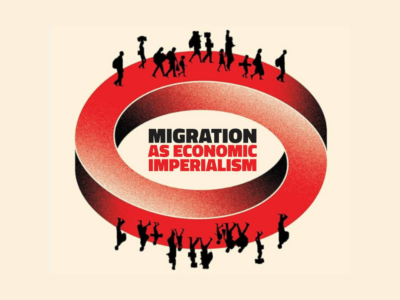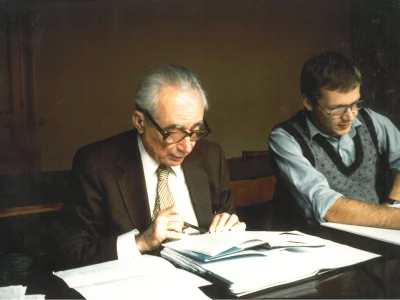Working paper
I am currently writing a book about the work of Arghiri Emmanuel. I am dealing with both the past–using his archive–but also trying to situate his work in 21st-century capitalism in terms of the qualitative and quantitative changes since Emmanuel published his books and articles between 1965 and 1990.
Emmanuel’s main contribution to the political economy was the theory of unequal exchange. It deals with imperialism by means of trade, based on international wage differentials. It is a criticism of the classic David Ricardo’s theorem of “Comparative Cost”–which states that all nations benefit from international trade–as well as of the new neoclassical theory of trade. Alternatively, Emmanuel bases his theory on the Marxist concept of value.
Therefore, in the following, the word “price” refers to the actual money paid for goods or wages, while the word “value” refers to the Marxist concept. The value of labour and the value of goods refers to the socially necessary amount of work it takes to reproduce the labour power and produce the goods. Given the globalization of capitalism, there is a global value of labour while the price of labour differs due to the polarization of globalized capitalism and the existence of state borders. While capital and goods can move freely, the movement of the labour force is much more confined.
While Emmanuel focuses on how international trade accentuates the polarization of global capitalism into a centre-periphery structure of exploited and exploiting counties, I will also look at how unequal exchange between nations works at the level of the individual wage labourer.
The prerequisites and mechanism are the same. A difference in price of labor due to the immobility of labour, and a tendency towards the formation of a global value of labour and goods.
The balance
If we look at the individual wage labourer, there is a balance between the appropriation of value through the consumption of goods and the exploitation of labour through the extract of surplus plus value in the working process.
While the value transfer from the Global South to the Global North in the form of profit is commonly accepted in Marxist theories of imperialism, the value transfer in the form of commodities produced by low-wage labour being consumed by high-wage workers is controversial, as it calls into question the idea of global working-class unity and solidarity against global capitalism.
However, the fact that you are a wage earner does not necessarily mean that you are exploited. Some wage workers consume more value than they create. In concrete terms: the value (with the relatively low price) of the smartphones, iPads, sneakers, t-shirts, IKEA furniture, chocolate bars, bananas, coffee, etc. produced in the Global South and consumed by workers in the Global North, may be greater than the value extracted from the wage earners in the working process.
Already in 1857, Marx discussed the possibility of workers drawing advantages from the labour of other workers. This happens when the goods some workers produce are sold for less than their value and consumed by other workers who can afford them because of the higher wages they are paid. As he wrote in the Grundrisse: [1]
“As regards the other workers, the case is entirely the same; they gain from the depreciated commodity only in relation (1) as they consume it; (2) relative to the size of their wage, which is determined by necessary labour.”
It is certainly possible for a wage earner to consume more value than she or he produces. This is not a matter of morals but of mathematics. The theory is not controversial when the wage earner is an administrative director of a bank or a professional football player, but it becomes so when it is between workers in the world.
The unequal exchange developed through the 19th century as colonialism divided the world into rich and poor countries with growing differences in wage levels. The unequal exchange accelerated throughout the 20th century with the growth of transnational companies and international trade, providing super-profits for capital and cheap goods, based on the exploitation of low-wage labour, for the consumers in the imperialist core.
Assuming a globalized value of labour, and given the huge difference in the price of labour (wage) between the Global North and Global South, then being a wage labourer does not necessarily imply that you are exploited. It is a matter of calculation. A worker in the electronic industry in South East Asia, and a worker in the automobile industry in North America or the EU are both wage laborers. Both create value and both are a source of surplus value and hence profit for capital. Their labour is exploited. However given the high wage level in the Global North, the worker can appropriate more value through the consumption of goods produced by low-wage labour, than the value extracted through the labour process. As Emmanuel states:[2]
…”a labour aristocracy by definition producing less value than their wages allow them to appropriate and thus becoming the objective allies of imperialism, which brings them the supplement…”
If we look at the wage labour in the Global North then the appropriation of value through consumption – due to the relatively high wage level, is higher than the exploitation by capital through the surplus value extracted through the labour process.
In the Global South, the value consumed covers only the value of labour power (sometimes less called super-exploitation) Hence the exploitation by surplus value excide the value appropriated by consumption.
The advantages of the individual perspective
The advances of looking at the unequal exchange, as this balance between appropriation of value through consumption and capitalist exploitation by wage labour in the national framework, is that it underlines the dynamics of the process.
The acquired value by workers in the Global North through the consumption of goods produced by low-wage workers has been growing throughout most of the 20th century. The unequal exchange reached its peak around 2010, but is now, for the first time in a century, declining, partly due to rising wages in China, partly due to declining North-South trade as the neoliberal world market erodes.[3]
This way of looking at the unequal exchange, at the individual level, as a balance between appropriation through consumption and exploitation through surplus value, also opens up the possibility to differentiate between different sectors of the working class within each country–between the high-wage labour aristocracy and lower-waged immigrant labour in the Global North.
The balance, between appropriation by consumption and the exploitation of labour in the Global North, is quite concrete and can be calculated, both in terms of transfer on the national level and for individuals.[4]
I have made a rough estimate of the threshold above which workers receiving that income ceases to be exploited in the global context. I base this estimate on the wage ratio between OECD countries and non-OECD countries, which is 1 to 11, combined with OECD figures on average wages.[5] The average annual wage in the OECD in 2019 was $48,587; a wage ratio of 11:1 between OECD and non-OECD countries gives a non-OECD annual wage of $4,417.[6] The global wage factor is calculated to be 6.5, which gives us $28,710 as the average global wage, which can be considered the global value of labour. There are many uncertainties and sources of error in information on wages and the number of wage-workers in different countries, and the OECD average wage covers all wages, high and low. Even with these caveats, it is interesting to estimate the approximate range of the global value of labour in terms of money.
Finally, this perspective on unequal exchange has the advantage of placing a political strategy in the focus.
Political consequences
In the description of unequal exchange’s political consequences, in the form of the constitution of the labour aristocracy and the parasite state, it is important to keep in mind that these phenomena and processes are historical. Just as unequal exchange can explain the emergence of these political trends, changes in the balance between appropriation through consumption and exploitation by wage labour in a national context will have political consequences.
There is, of course, no one-to-one relationship between the above-mentioned economic balance and the revolutionary potential of a given working class. Want and misery do not necessarily lead to revolution; they can even sometimes be an obstacle, and there are many other factors involved. A revolutionary situation requires both that the ruling class can no longer rule in the old way, and that the oppressed will not allow being ruled in the old way anymore. However, there is also a correspondence between material interests and political action.
The “parasite state theory” of the Communist Working Circle, did not only state that the working class gains from imperialism.[7] The bourgeoisiefication was a historical phenomenon created by a very specific historical, economic, and political development in capitalism, and since it is a historical explanation, it opens up the possibility of change in the position of the class.
The “parasite state” theory states that the working class in Western Europe and North America occupies a dual position. They are an object of exploitation as they perform wage labour which creates surplus value and thus profit for capital. However, by virtue of their relatively high wage level, they are also able to acquire value through their consumption of goods produced by low-wage labor in the Global South. Whether they are exploited or exploiter – from a global perspective – is a matter of a balance between the acquisition of value through consumption and exploitation through their contribution of surplus value to capital.
Without this double perspective on the position of the working class, the “parasite state” theory becomes static and loses its revolutionary content. Via this double perspective on the relation between – exploitation in the national framework and international exploitation, the theory can explain both the historical process of bourgeoisiefication and the working class’ support for colonialism and imperialism up through the 20th century, but at the same time maintain a future possibility of the class as gravediggers of capitalism.
If one denies the significance and consequences of imperialism’s transfusion of value to the working class in the global North, one falls into the fog of seeing every economic struggle as a revolutionary struggle on the road to socialism. If one denies that the highly paid worker in the imperialist countries produces value, surplus value, and so profit, then one rejects the possibility that the working class, in the imperialist centre, ever can play a role in the struggle against capitalism. Moreover, one loses sight of political activity in the Global North and gives up the task set by Lenin: [8]
“To be able to seek, find and correctly determine the specific path or the particular turn of events that will lead the masses to the real, decisive and final revolutionary struggle—such is the main objective of communism in Western Europe and America today.”
Will the current decline of US hegemony and the rise of China, change the balance between the appropriation of value and exploration of the working class in the Global North? If so what will the political consequence be? Will the working class support imperialism or will they join forces with the Global South?
The hallmark of a Marxist is to have an analysis, strategy, and praxis for the context in which you are situated.
Torkil Lauesen July 2023
- Marx, Karl (1857) Notebook IV: The Chapter on Capital, The general rate of profit. Grundrisse: Foundations of the Critique of Political Economy (Rough Draft Baltimore. Penguin, 1973. https://www.marxists.org/archive/marx/works/1857/grundrisse/ch08.htm#p434. Accessed 22.3.2023. ↑
- Emmanuel, A. (1986) Preface to, Manifest Communist Working Group, Unequal Exchange and the Prospects for Socialism in a Divided World. Page 9. Publishing House Manifest. Copenhagen 1986. ↑
- Hickel, Jason, Sullivan, Dylan & Zoomkawala, Huzaifa (2021) Plunder in the Post-Colonial Era: Quantifying Drain from the Global South Through Unequal Exchange, 1960–2018. New Political Economy, vol. 26 no. 6, page 1030-1047. ↑
- Köhler, Gernot (1997) The Structure of Global Money and World Tables of Unequal Exchange Journal of World-Systems Research, vol. 4, pp 145-168, and Lauesen, Torkil (2021) Riding on the wave, Sweden´s Integration onto the Imperialist World System. Page 146. Kersplebedeb Montreal 2021. ↑
- Cope, Zak (2015), Divided World Divided Class. Global Political Economy and the Stratification of Labour under Capitalism. Page 254–56. Montreal: Kersplebedeb, 2015. ↑
- OECD (2021) “Average wages.” https://data.oecd.org/earnwage/average-wages.htm. Accessed 21.3.2023. ↑
-
Lauesen, Torkil (2018) The parasite state in theory and practice. Pages 285–300. Journal of Labor and Society, Volume 21. Issue 3.↑
- Lenin, V. I (1920) “Left-Wing” Communism: an Infantile Disorder. In Collected Works, Volume 31, pp. 112. Progress Publishers, USSR, 1964. https://www.marxists.org/archive/lenin/works/1920/lwc/ch10.htm↑





I’m really looking forward to this book. I’ve read all your other works and find them very insightful and concise. Long live!